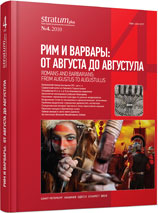Данные письменных и археологических источников о появлении германцев на Боспоре (проблема выделения «германских древностей» на Боспоре)
Appearance of the Germans in Bosphorus in the Light of Written and Archaeological Records (The Problem of Identifi cation of “German Antiquities” in Cimmerian Bosporus)
Author(s): Oleg V. SharovSubject(s): History, Archaeology, Military history, Ancient World, Migration Studies
Published by: Издательский дом Stratum, Университет «Высшая антропологическая школа»
Keywords: Jordan; Cimmerian Bosporus; North Black Sea region; Pantikapej; Tanais; Meotida; Late Roman period; Goths; Oyum; Germans; buckles; fi bulas; shields; Chernyakhov culture
Summary/Abstract: The paper deals with the main types of objects of the German origin found in the Late Roman assemblages of Bosphorus (150—350 AD).Group 1, В2/С1 period (150—200): bronze buckles with rectangular frames on the tongue from Kerch and Gorodskoi farmstead on the Kuban, having parallels in East Prussia; double-tongued buckles with rectangular girdles, common in Denmark, in the Przeworsk culture area and on the Western Balts’ lands; long-thorned umbos of the German type from Kerch and Tanais. The main types of these finds are connected with the Baltic region, Scandinavia, and particularly with East Prussia.Group 2, С1 period (180—260 AD): shield bugs of the “Konin” and “Chorula” types from Tanais, associated with horizon IIа of the interments with the Przeworsk culture weaponry. It is during this period that the German-Bosphorus type pendants in the form of Thor’s hammers appear in the Bosphorus region. German traditions can be seen also in the three-handled vases from Kerch, as well as in the hand-modeled pottery from Ilurat, Tiritaka, and Myrmekion.Group 3, С2a period (260/270—280/290 AD): belt head of Raddatz J 2—1 type from Kerch, 1896; gold rings from Phanagoria, 1842. These types are characteristic of the horizon of palatine burials in Germany. Polychromic objects of the “Illerup-Kerch” group, belonging to the German-Bosporan tradition, make their appearance in Kerch.Group 4, С2b-C3 period (290/300—350/360 AD): hinged-pin fibulas Ambroz 16/2—3 and warrior’s fibulas Ambroz 17 in Kerch, in the tombs of Zamorskoe, Zyuk cape and Sirenevaya Bay; combs of Thomas I type from Kerch and Dzurg-Oba; shield bugs of К2 type from Sirenevaya Bay and Kerch, small two-blade fibulae of the Chernyakhov tradition from Kerch tombs; bone pyramidal and amber mushroom-shaped pendants, gray clay pottery of the Chernyakhov appearance from Kerch.Altogether, four waves of German influence can be seen in the Late Roman materials of Bosphorus:Wave 1 — Baltic-Scandinavian;Wave 2 — Wielbark-Przeworsk;Wave 3 — Central European-Scandinavian;Wave 4 — Chernyakhov.
Journal: Stratum plus. Археология и культурная антропология
- Issue Year: 2010
- Issue No: 4
- Page Range: 251-285
- Page Count: 35
- Language: Russian

